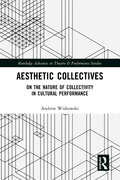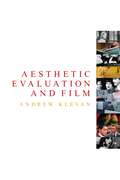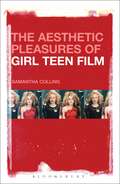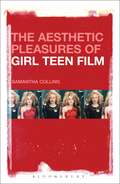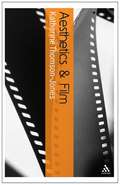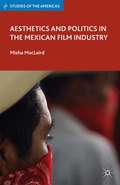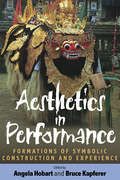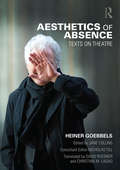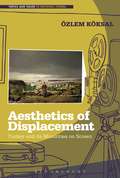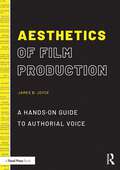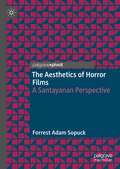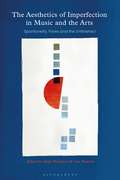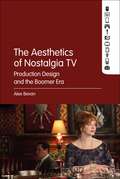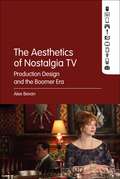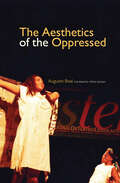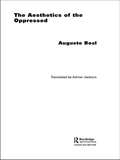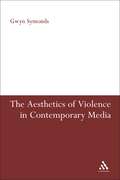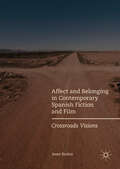- Table View
- List View
Aesthetic Collectives: On the Nature of Collectivity in Cultural Performance (Routledge Advances in Theatre & Performance Studies)
by Andrew WiskowskiThis book focuses attention on groups of performing people that are unique aesthetic objects, the focus of an artist’s vision, but at the same time a collective being; a singular, whole mass that exists and behaves like an individual entity. This text explores this unique experience, which is far from rare or special. Indeed, it is pervasive, ubiquitous and has, since the dawn of performance, been with us. Surveying installation art from Vanessa Beecroft & Kanye West, Greek tragedy, back-up dancing groups and even the mass dance of clubbing crowds, this text examines and names this phenomenon: Aesthetic Collectives. Drawing on a range of methods of investigation spanning performance studies, acting theory, studies of atmosphere and affect and sociology it presents an intervention in the literature for something that has long deserved its own attention. This book will be of great interest to scholars, students and practitioners in performance studies, theatre, live art, sociology (particularly of groups and subcultures), cultural studies and cultural geography.
Aesthetic Collectives: On the Nature of Collectivity in Cultural Performance (Routledge Advances in Theatre & Performance Studies)
by Andrew WiskowskiThis book focuses attention on groups of performing people that are unique aesthetic objects, the focus of an artist’s vision, but at the same time a collective being; a singular, whole mass that exists and behaves like an individual entity. This text explores this unique experience, which is far from rare or special. Indeed, it is pervasive, ubiquitous and has, since the dawn of performance, been with us. Surveying installation art from Vanessa Beecroft & Kanye West, Greek tragedy, back-up dancing groups and even the mass dance of clubbing crowds, this text examines and names this phenomenon: Aesthetic Collectives. Drawing on a range of methods of investigation spanning performance studies, acting theory, studies of atmosphere and affect and sociology it presents an intervention in the literature for something that has long deserved its own attention. This book will be of great interest to scholars, students and practitioners in performance studies, theatre, live art, sociology (particularly of groups and subcultures), cultural studies and cultural geography.
Aesthetic evaluation and film
by Andrew KlevanThis book provides an in-depth, holistic examination of evaluative aesthetics and criticism as they apply to film. Organised around the explanation of key concepts, it illuminates connections between the work of philosophers, theorists and critics, and demonstrates the evaluation of form through the close analysis of film sequences. The book advocates that aesthetic evaluation should be flexibly informed by a cluster of concerns including medium, convention, prominence, pattern and relation; and rather than privileging a particular theory or film style, it models a type of approach, attention, process and discourse. Suitable for students of film studies and philosophical aesthetics at both undergraduate and postgraduate levels, Aesthetic evaluation and film also provides a framework for academics researching or teaching in the area. At the same time, the crisp and lucid style will make the book accessible to a wider readership.
Aesthetic evaluation and film (Current Practices in Ophthalmology)
by Andrew KlevanThis book provides an in-depth, holistic examination of evaluative aesthetics and criticism as they apply to film. Organised around the explanation of key concepts, it illuminates connections between the work of philosophers, theorists and critics, and demonstrates the evaluation of form through the close analysis of film sequences. The book advocates that aesthetic evaluation should be flexibly informed by a cluster of concerns including medium, convention, prominence, pattern and relation; and rather than privileging a particular theory or film style, it models a type of approach, attention, process and discourse. Suitable for students of film studies and philosophical aesthetics at both undergraduate and postgraduate levels, Aesthetic evaluation and film also provides a framework for academics researching or teaching in the area. At the same time, the crisp and lucid style will make the book accessible to a wider readership.
The Aesthetic Pleasures of Girl Teen Film
by Samantha CollingWhat is 'fun' about the Hollywood version of girlhood? Through re-evaluating notions of pleasure and fun, The Aesthetic Pleasures of Girl Teen Film forms a study of Hollywood girl teen films between 2000-2010. By tracing the aesthetic connections between films such as Mean Girls (Waters, 2004), Hairspray (Shankman, 2007), and Easy A (Gluck, 2010), the book articulates the specific types of pleasure these films offer as a means to understand how Hollywood creates gendered ideas of fun. Rather than condemn these films as 'guilty pleasures' this book sets out to understand how they are designed to create experiences that feel as though they express desires, memories, or fantasies that girls supposedly share in common. Providing a practical model for a new approach to cinematic pleasures The Aesthetic Pleasures of Girl Teen Film proposes that these films offer a limited version of girlhood that feels like potential and promise but is restricted within prescribed parameters.
The Aesthetic Pleasures of Girl Teen Film
by Samantha CollingWhat is 'fun' about the Hollywood version of girlhood? Through re-evaluating notions of pleasure and fun, The Aesthetic Pleasures of Girl Teen Film forms a study of Hollywood girl teen films between 2000-2010. By tracing the aesthetic connections between films such as Mean Girls (Waters, 2004), Hairspray (Shankman, 2007), and Easy A (Gluck, 2010), the book articulates the specific types of pleasure these films offer as a means to understand how Hollywood creates gendered ideas of fun. Rather than condemn these films as 'guilty pleasures' this book sets out to understand how they are designed to create experiences that feel as though they express desires, memories, or fantasies that girls supposedly share in common. Providing a practical model for a new approach to cinematic pleasures The Aesthetic Pleasures of Girl Teen Film proposes that these films offer a limited version of girlhood that feels like potential and promise but is restricted within prescribed parameters.
Aesthetics and Film (Bloomsbury Aesthetics)
by Katherine Thomson-JonesAesthetics and Film is a philosophical study of the art of film. Its motivation is the recent surge of interest among analytic philosophers in the philosophical implications of central issues in film theory and the application of general issues in aesthetics to the specific case of film. Of particular interest are questions concerning the distinctive representational capacities of film art, particularly in relation to realism and narration, the influence of the literary paradigm in understanding film authorship and interpretation, and our imaginative and affective engagement with film. For all of these questions, Katherine Thomson-Jones critically compares the most compelling answers, driving home key points with a wide range of film examples including Wiene's The Cabinet of Doctor Caligari, Eisenstein's October, Hitchcock's Rear Window, Kubrick's The Shining and Sluizer's The Vanishing. Students and scholars of aesthetics and cinema will find this an illuminating, accessible and highly enjoyable investigation into the nature and power of a technologically evolving art form.
Aesthetics and Film (Bloomsbury Aesthetics)
by Katherine Thomson-JonesAesthetics and Film is a philosophical study of the art of film. Its motivation is the recent surge of interest among analytic philosophers in the philosophical implications of central issues in film theory and the application of general issues in aesthetics to the specific case of film. Of particular interest are questions concerning the distinctive representational capacities of film art, particularly in relation to realism and narration, the influence of the literary paradigm in understanding film authorship and interpretation, and our imaginative and affective engagement with film. For all of these questions, Katherine Thomson-Jones critically compares the most compelling answers, driving home key points with a wide range of film examples including Wiene's The Cabinet of Doctor Caligari, Eisenstein's October, Hitchcock's Rear Window, Kubrick's The Shining and Sluizer's The Vanishing. Students and scholars of aesthetics and cinema will find this an illuminating, accessible and highly enjoyable investigation into the nature and power of a technologically evolving art form.
Aesthetics and Politics in the Mexican Film Industry (Studies of the Americas)
by M. MacLairdEvaluating a broad selection of Mexican films produced from the early 1990s to the present, this study examines how production methods, audience demographics, and aesthetic approaches have changed throughout the past two decades and how these changes relate to the country's transitions to a democratic political system and a free-market economy.
Aesthetics in Performance: Formations of Symbolic Construction and Experience
In various ways, the essays presented in this volume explore the structures and aesthetic possibilities of music, dance and dramatic representation in ritual and theatrical situations in a diversity of ethnographic contexts in Europe, the Americas, Africa and Asia. Each essay enters into a discussion of the “logic” of aesthetic processes exploring their social and political and symbolic import. The aim is above all to explore the way artistic and aesthetic practices in performance produce and structure experience.
Aesthetics of Absence: Texts on Theatre
by Heiner GoebbelsAesthetics of Absence presents a significant challenge to the many embedded assumptions and hierarchical structures that have become ‘naturalised’ in western theatre production. This is the first English translation of a new collection of writings and lectures by Heiner Goebbels, the renowned German theatre director, composer and teacher. These writings map Goebbels’ engagement with ‘Aesthetics of Absence’ through his own experience at the forefront of innovative music-theatre and performance making. In this volume, Goebbels reflects on works created over a period of more than 20 years staged throughout the world; introduces some of his key artistic influences, including Robert Wilson and Jean-Luc Godard; discusses the work of his students and ex-students, the collective Rimini Protokoll; and sets out the case for a radical rethinking of theatre and performance education. He gives us a rare insight into the rehearsal process of critically acclaimed works such as Eraritjaritjaka and Stifters Dinge, explaining in meticulous detail the way he weaves an eclectic range of references from fine art, theatre, literature, politics, anthropology, contemporary and classical music, jazz and folk, into his multi-textured music-theatre compositions. As an artist who is prepared to share his research and demystify the processes through which his own works come into being, as a teacher with a coherent pedagogical strategy for educating the next generation of theatre-makers, in this volume, Goebbels brings together practice, research and scholarship.
Aesthetics of Absence: Texts on Theatre
by Heiner GoebbelsAesthetics of Absence presents a significant challenge to the many embedded assumptions and hierarchical structures that have become ‘naturalised’ in western theatre production. This is the first English translation of a new collection of writings and lectures by Heiner Goebbels, the renowned German theatre director, composer and teacher. These writings map Goebbels’ engagement with ‘Aesthetics of Absence’ through his own experience at the forefront of innovative music-theatre and performance making. In this volume, Goebbels reflects on works created over a period of more than 20 years staged throughout the world; introduces some of his key artistic influences, including Robert Wilson and Jean-Luc Godard; discusses the work of his students and ex-students, the collective Rimini Protokoll; and sets out the case for a radical rethinking of theatre and performance education. He gives us a rare insight into the rehearsal process of critically acclaimed works such as Eraritjaritjaka and Stifters Dinge, explaining in meticulous detail the way he weaves an eclectic range of references from fine art, theatre, literature, politics, anthropology, contemporary and classical music, jazz and folk, into his multi-textured music-theatre compositions. As an artist who is prepared to share his research and demystify the processes through which his own works come into being, as a teacher with a coherent pedagogical strategy for educating the next generation of theatre-makers, in this volume, Goebbels brings together practice, research and scholarship.
Aesthetics of Displacement: Turkey and its Minorities on Screen (Topics and Issues in National Cinema)
by Ozlem KoksalDisplacement does not only have an effect on groups' and individuals' ways of relating to their identity and their past but the knowledge and experience of it also has an impact on its representation. Looking at films that represent the experience of displacement in relation to Turkey's minorities, Aesthetics of Displacement argues that there is a particular aesthetic continuity among the otherwise unrelated films. Ozlem Koksal focuses on films that bring taboo issues concerning the repression of minorities into visibility, arguing that the changing political and social conditions determine not only the types of stories told but also the ways in which these stories are told.Focusing on aesthetic and narrative continuities, the films discussed include Ararat, Waiting for the Clouds and Once Upon a Time in Anatolia among others. Each film is examined in light of major historical event(s) and their context (political and social) as well as the impact these events had on the construction of both minority and Turkish identity.
Aesthetics of Film Production: A Hands-On Guide to Authorial Voice
by James B. JoyceExploring aesthetic decision-making skills through active, critical interpretation of the screenplay, this book investigates the ways filmmakers translate a screenplay into a powerful film. Guiding the reader through the formal choices a filmmaker makes, this book encompasses all aspects of the filmmaking process, including directing, acting, cinematography, lighting, production design, sound, and editing. Author Joyce illustrates how to apply aesthetics in a way that encourages creative thinking and stylistic choices, while emphasizing the importance of active decision-making to foreground the screenplay in the filmmaking process. Focusing on how films should be crafted stylistically from beat to beat, the book provides tangible footholds to assist filmmakers with the aesthetic decision-making process, empowering filmmakers to create films to resonate emotionally and intellectually. Ideal for students of filmmaking and aspiring filmmakers looking to train their gut and hone their creative and aesthetic decision-making in the filmmaking process. Additional online screenplay samples show how one singular story can be told with different emphasis and narrative perspectives.
Aesthetics of Film Production: A Hands-On Guide to Authorial Voice
by James B. JoyceExploring aesthetic decision-making skills through active, critical interpretation of the screenplay, this book investigates the ways filmmakers translate a screenplay into a powerful film. Guiding the reader through the formal choices a filmmaker makes, this book encompasses all aspects of the filmmaking process, including directing, acting, cinematography, lighting, production design, sound, and editing. Author Joyce illustrates how to apply aesthetics in a way that encourages creative thinking and stylistic choices, while emphasizing the importance of active decision-making to foreground the screenplay in the filmmaking process. Focusing on how films should be crafted stylistically from beat to beat, the book provides tangible footholds to assist filmmakers with the aesthetic decision-making process, empowering filmmakers to create films to resonate emotionally and intellectually. Ideal for students of filmmaking and aspiring filmmakers looking to train their gut and hone their creative and aesthetic decision-making in the filmmaking process. Additional online screenplay samples show how one singular story can be told with different emphasis and narrative perspectives.
The Aesthetics of Horror Films: A Santayanan Perspective
by Forrest Adam SopuckThis book analyzes the nature and functions of horror films from the vantage of a theoretical reconstruction of George Santayana’s account of beauty. This neo-Santayanan framework forms the conceptual backdrop for a new model of horror’s aesthetic enjoyment, the nature of which is detailed through the examination of plot, cinematic, and visual devices distinctive of the popular genre. According to this model, the audience derives pleasure from the films through confronting the aversive scenarios they communicate and rationalizing a denial of their personal applicability. The films then come to embody these acts of self-assertion and intellectual overcoming and become objects of pride. How horror films can acquire necropolitical functions within the context of abusive systems of power is also clarified. These functions, which exploit the power of anti-tragedy, downward social comparison, or vicarious emotion, work to remediate aggressive, ascetic, or revolutionary impulses in ways that are not injurious to the status quo. This book champions horror as a source of self-empowerment and unmitigated beauty, but also attests to the potential social harms of the genre.
The Aesthetics of Imperfection in Music and the Arts: Spontaneity, Flaws and the Unfinished
by Andy Hamilton and Lara PearsonThe aesthetics of imperfection emphasises spontaneity, disruption, process and energy over formal perfection and is often ignored by many commentators or seen only in improvisation. This comprehensive collection is the first time imperfection has been explored across all kinds of musical performance, whether improvisation or interpretation of compositions. Covering music, visual art, dance, comedy, architecture and design, it addresses the meaning, experience, and value of improvisation and spontaneous creation across different artistic media. A distinctive feature of the volume is that it brings together contributions from theoreticians and practitioners, presenting a wider range of perspectives on the issues involved. Contributors look at performance and practice across Western and non-Western musical, artistic and craft forms. Composers and non-performing artists offer a perspective on what is 'imperfect' or improvisatory within their work, contributing further dimensions to the discourse. The Aesthetics of Imperfection in Music and the Arts features 39 chapters organised into eight sections and written by a diverse group of scholars and performers. They consider divergent definitions of aesthetics, employing both 18th-century philosophy and more recent socially and historically situated conceptions making this an essential, up-to-date resource for anyone working on either side of the perfection-imperfection debate.
The Aesthetics of Imperfection in Music and the Arts: Spontaneity, Flaws and the Unfinished
The aesthetics of imperfection emphasises spontaneity, disruption, process and energy over formal perfection and is often ignored by many commentators or seen only in improvisation. This comprehensive collection is the first time imperfection has been explored across all kinds of musical performance, whether improvisation or interpretation of compositions. Covering music, visual art, dance, comedy, architecture and design, it addresses the meaning, experience, and value of improvisation and spontaneous creation across different artistic media. A distinctive feature of the volume is that it brings together contributions from theoreticians and practitioners, presenting a wider range of perspectives on the issues involved. Contributors look at performance and practice across Western and non-Western musical, artistic and craft forms. Composers and non-performing artists offer a perspective on what is 'imperfect' or improvisatory within their work, contributing further dimensions to the discourse. The Aesthetics of Imperfection in Music and the Arts features 39 chapters organised into eight sections and written by a diverse group of scholars and performers. They consider divergent definitions of aesthetics, employing both 18th-century philosophy and more recent socially and historically situated conceptions making this an essential, up-to-date resource for anyone working on either side of the perfection-imperfection debate.
The Aesthetics of Nostalgia TV: Production Design and the Boomer Era
by Alex BevanThe Aesthetics of Nostalgia TV explores the aesthetic politics of nostalgia for 1950s and 60s America on contemporary television. Specifically, it looks at how nostalgic TV production design shapes and is shaped by larger historical discourses on gender and technological change, and America's perceived decline as a global power. Alex Bevan argues that the aesthetics of nostalgic TV tell stories of their own about historical decline and progress, and the place of the baby boomer television suburb in American national memory. She contests theories on nostalgia that see it as stagnating, regressive, or a reversion to outdated gender and racial politics, and the technophobic longing for a bygone era; and, instead, argues nostalgia is an important form of historical memory and vehicle for negotiating periods of historical transition. The book addresses how and why the shows construct the boomer era as a placeholder for gender, racial, technological, and declensionist discourses of the present. The book uses Mad Men (AMC, 2007-2015), Ugly Betty (ABC, 2006-2010), Desperate Housewives (ABC, 2004-2012), and film remakes of 1950s and 60s family sitcoms as primary case studies.
The Aesthetics of Nostalgia TV: Production Design and the Boomer Era
by Alex BevanThe Aesthetics of Nostalgia TV explores the aesthetic politics of nostalgia for 1950s and 60s America on contemporary television. Specifically, it looks at how nostalgic TV production design shapes and is shaped by larger historical discourses on gender and technological change, and America's perceived decline as a global power. Alex Bevan argues that the aesthetics of nostalgic TV tell stories of their own about historical decline and progress, and the place of the baby boomer television suburb in American national memory. She contests theories on nostalgia that see it as stagnating, regressive, or a reversion to outdated gender and racial politics, and the technophobic longing for a bygone era; and, instead, argues nostalgia is an important form of historical memory and vehicle for negotiating periods of historical transition. The book addresses how and why the shows construct the boomer era as a placeholder for gender, racial, technological, and declensionist discourses of the present. The book uses Mad Men (AMC, 2007-2015), Ugly Betty (ABC, 2006-2010), Desperate Housewives (ABC, 2004-2012), and film remakes of 1950s and 60s family sitcoms as primary case studies.
The Aesthetics of the Oppressed
by Augusto BoalAugusto Boal's workshops and theatre exercises are renowned throughout the world for their life-changing effects. At last this major director, practitioner, and author of many books on community theatre speaks out about the subjects most important to him – the practical work he does with diverse communities, the effects of globalization, and the creative possibilities for all of us.
The Aesthetics of the Oppressed
by Augusto BoalAugusto Boal's workshops and theatre exercises are renowned throughout the world for their life-changing effects. At last this major director, practitioner, and author of many books on community theatre speaks out about the subjects most important to him – the practical work he does with diverse communities, the effects of globalization, and the creative possibilities for all of us.
The Aesthetics of Violence in Contemporary Media
by Gwyn SymondsThe topic of violence in the media seems as inundated as can be. Countless studies and research projects have been conducted, mostly to show its negative effects on society. What Gwynneth Symonds proposes, though, takes this significant topic one step further: studying the aesthetics of media violence. By defining key terms like the 'graphic' nature and 'authenticity' of violent representations, and discussing how those definitions are linked to actual violence outside the film and television screen, Symonds broadens the arena of study. Engagingly written, The Aesthetics of Violence in Contemporary Media fills an important gap. Symonds uses existing studies for the empirical audience reception data, together with discussions of the different representations of violence to look at violence in the media as an art form in of itself. By looking at The Simpsons, Bowling for Columbine and Norma Khouri's Forbidden Love, just to name a few, Symonds cross-analyzes violence in multiple media to see their affective role in audience reception - an important aspect when discussing media. The book strikes a balance between the readers' need to see how theory matches what actually happens in the texts in question and the demands of a theoretical overview.
Affect and Belonging in Contemporary Spanish Fiction and Film: Crossroads Visions
by Jesse BarkerThis book brings together recent Spanish fictions and films that point to individualism as the root problem driving diverse circumstances of social, economic, and psychological suffering in the present and recent past. The works privilege sensation, movement, and emotion—rather than identity—as the core elements of existential experience. However, the works also problematize notions of intersubjectivity, confronting ideals of affective immersion and cultural nomadism with the concrete contexts that shape particular lives and social formations. This confrontation underlies a series of ‘crossroads’, or productive engagements, that guide the book’s five main chapters: locally rooted identity and global cultural circuits; historical contexts and universal modes of being; personal authenticity and consumer culture; migration and cultural identity; Spain's historical underdevelopment and impending future crises. All of these issues make affective connection and attachment the greatest existential challenge facing individuals and collectives in the contemporary world, both in Spain and elsewhere.
Affect and Embodied Meaning in Animation: Becoming-Animated (Routledge Advances in Film Studies)
by Sylvie BissonnetteThis book combines insights from the humanities and modern neuroscience to explore the contribution of affect and embodiment on meaning-making in case studies from animation, video games, and virtual worlds. As we interact more and more with animated characters and avatars in everyday media consumption, it has become vital to investigate the ways that animated environments influence our perception of the liberal humanist subject. This book is the first to apply recent research on the application of the embodied mind thesis to our understanding of embodied engagement with nonhumans and cyborgs in animated media, analyzing works by Émile Cohl, Hayao Miyazaki, Tim Burton, Norman McLaren, the Quay Brothers, Pixar, and many others. Drawing on the breakthroughs of modern brain science to argue that animated media broadens the viewer’s perceptual reach, this title offers a welcome contribution to the growing literature at the intersection of cognitive studies and film studies, with a perspective on animation that is new and original. ‘Affect and Embodied Meaning in Animation’ will be essential reading for researchers of Animation Studies, Film and Media Theory, Posthumanism, Video Games, and Digital Culture, and will provide a key insight into animation for both undergraduate and graduate students. Because of the increasing importance of visual effect cinema and video games, the book will also be of keen interest within Film Studies and Media Studies, as well as to general readers interested in scholarship in animated media.
